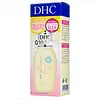What's inside
What's inside
 Key Ingredients
Key Ingredients

 Benefits
Benefits

 Concerns
Concerns

No concerns
 Ingredients Side-by-side
Ingredients Side-by-side

Water
Skin ConditioningButylene Glycol
HumectantOlea Europaea Fruit Oil
MaskingSqualane
EmollientPentylene Glycol
Skin ConditioningPolysorbate 60
EmulsifyingStearic Acid
CleansingGlyceryl Stearate
EmollientPropylene Glycol Stearate
Skin ConditioningCetyl Palmitate
EmollientLeuconostoc/Radish Root Ferment Filtrate
AntimicrobialPhenoxyethanol
PreservativeSorbitan Stearate
EmulsifyingCarbomer
Emulsion StabilisingPotassium Hydroxide
BufferingTocopherol
AntioxidantSodium Hyaluronate
HumectantRoyal Jelly Extract
Skin ConditioningPanax Ginseng Root Extract
EmollientWater, Butylene Glycol, Olea Europaea Fruit Oil, Squalane, Pentylene Glycol, Polysorbate 60, Stearic Acid, Glyceryl Stearate, Propylene Glycol Stearate, Cetyl Palmitate, Leuconostoc/Radish Root Ferment Filtrate, Phenoxyethanol, Sorbitan Stearate, Carbomer, Potassium Hydroxide, Tocopherol, Sodium Hyaluronate, Royal Jelly Extract, Panax Ginseng Root Extract
Water
Skin ConditioningGlycerin
HumectantButylene Glycol
HumectantPentylene Glycol
Skin ConditioningHydrogenated Lecithin
EmulsifyingAcacia Mearnsii Bark Extract
Skin ConditioningAloe Barbadensis Leaf Juice
Skin ConditioningPhenoxyethanol
PreservativeUbiquinone
AntioxidantPEG-5 Soy Sterol
EmulsifyingTocotrienols
Skin ConditioningXanthan Gum
EmulsifyingCarbomer
Emulsion StabilisingSodium Hyaluronate
HumectantPotassium Hydroxide
BufferingElaeis Guineensis Kernel Oil
EmollientPalmitoyl Olive Leaf Extract
AntioxidantBiotin
AntiseborrhoeicCyanocobalamin
Skin ConditioningSodium Riboflavin Phosphate
Skin ConditioningWater, Glycerin, Butylene Glycol, Pentylene Glycol, Hydrogenated Lecithin, Acacia Mearnsii Bark Extract, Aloe Barbadensis Leaf Juice, Phenoxyethanol, Ubiquinone, PEG-5 Soy Sterol, Tocotrienols, Xanthan Gum, Carbomer, Sodium Hyaluronate, Potassium Hydroxide, Elaeis Guineensis Kernel Oil, Palmitoyl Olive Leaf Extract, Biotin, Cyanocobalamin, Sodium Riboflavin Phosphate
Ingredients Explained
These ingredients are found in both products.
Ingredients higher up in an ingredient list are typically present in a larger amount.
Butylene Glycol (or BG) is used within cosmetic products for a few different reasons:
Overall, Butylene Glycol is a safe and well-rounded ingredient that works well with other ingredients.
Though this ingredient works well with most skin types, some people with sensitive skin may experience a reaction such as allergic rashes, closed comedones, or itchiness.
Learn more about Butylene GlycolCarbomer is a polymer of acrylic acid. Its main role is to create a gel consistency.
A high amount of carbomer can cause pilling or balling up of products. Don't worry, most products contain 1% or less of carbomer.
Pentylene glycol is typically used within a product to thicken it. It also adds a smooth, soft, and moisturizing feel to the product. It is naturally found in plants such as sugar beets.
The hydrophilic trait of Pentylene Glycol makes it a humectant. As a humectant, Pentylene Glycol helps draw moisture from the air to your skin. This can help keep your skin hydrated.
This property also makes Pentylene Glycol a great texture enhancer. It can also help thicken or stabilize a product.
Pentylene Glycol also acts as a mild preservative and helps to keep a product microbe-free.
Some people may experience mild eye and skin irritation from Pentylene Glycol. We always recommend speaking with a professional about using this ingredient in your routine.
Pentylene Glycol has a low molecular weight and is part of the 1,2-glycol family.
Learn more about Pentylene GlycolPhenoxyethanol is a preservative that has germicide, antimicrobial, and aromatic properties. Studies show that phenoxyethanol can prevent microbial growth. By itself, it has a scent that is similar to that of a rose.
It's often used in formulations along with Caprylyl Glycol to preserve the shelf life of products.
Potassium hydroxide is commonly known as caustic potash. It is used to fix the pH of a product or as a cleaning agent in soap. In cleansers, it is used for the saponification of oils.
Sapnification is the process of creating fatty acid metal salts from triglycerides and a strong base. During this process, Potassium Hydroxide is used up and is not present in the final product.
Using high concentrations of Potassium Hydroxide have shown to irritate the skin.
Learn more about Potassium HydroxideSodium Hyaluronate is hyaluronic acid's salt form. It is commonly derived from the sodium salt of hyaluronic acid.
Like hyaluronic acid, it is great at holding water and acts as a humectant. This makes it a great skin hydrating ingredient.
Sodium Hyaluronate is naturally occurring in our bodies and is mostly found in eye fluid and joints.
These are some other common types of Hyaluronic Acid:
Learn more about Sodium HyaluronateWater. It's the most common cosmetic ingredient of all. You'll usually see it at the top of ingredient lists, meaning that it makes up the largest part of the product.
So why is it so popular? Water most often acts as a solvent - this means that it helps dissolve other ingredients into the formulation.
You'll also recognize water as that liquid we all need to stay alive. If you see this, drink a glass of water. Stay hydrated!
Learn more about Water